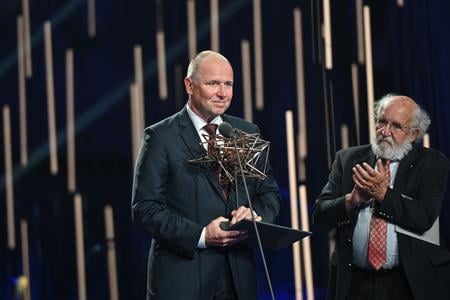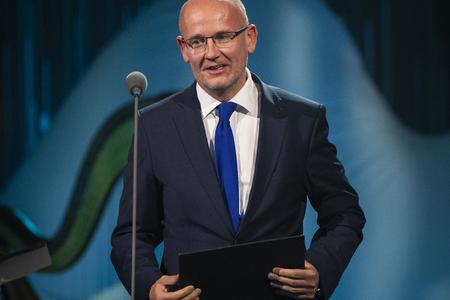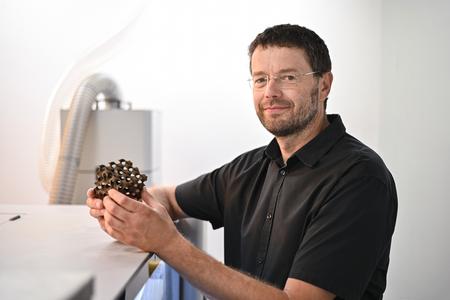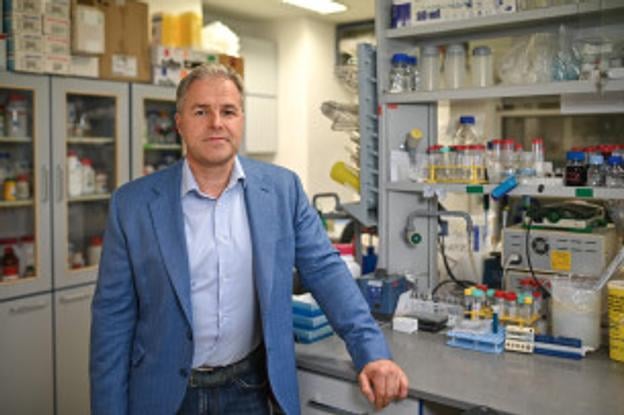Neuroimmunologist Norbert Žilka from the Institute of Neuroimmunology of the Slovak Academy of Sciences became involved in research into Alzheimer's disease after a chance meeting with his university professor on a train. From there, a series of events led to him reading a groundbreaking article on the disease, which made him realise that he wanted to study it. Today, he says, Slovakia is a leader in research into the degenerative condition.

Alzheimer’s disease manifests itself in many ways, such as memory loss. How does a person with this disease perceive the world? What is going on in their minds?
Psychologists have been able to gain a lot of information about this, especially in the early stages, and thanks to them we know that a patient's perception of what is happening is diametrically different to that of their family members in that they are not aware that something is happening to them. The way they perceive it is that something is changing in the world around them, and they identify that change as the problem. For instance, they will say that something must have happened to their computer, such as the software has changed to software they have never used before, but it is actually the same computer, with the same software. They're also capable of providing many reasons as to why they suddenly cannot use other devices they have used all their lives.
What often happens is that family members notice that their brother, sister or mother are behaving differently. They may be more aggressive or, on the contrary, very withdrawn because they are afraid of their surroundings. Society does not realise that these people are lost in their own world, that we must have respect for them, that this is an illness and not something they chose to have themselves. We are trying to change this, to destigmatise people [with Alzheimer's]. Just because someone has dementia it does not mean that they no longer belong to society. But it's not easy – people with the disease face negative reactions almost everywhere.
How many people in Slovakia suffer from the disease?
We don't have exact numbers, which makes us very angry, because for several years we have been trying to get the Health Ministry to support us in carrying out an epidemiological study that would help us to get the numbers. So, the estimate is based on numbers from neighbouring countries that have done their homework. Currently, there are more than 100,000 patients who could be diagnosed and roughly the same number of undiagnosed or incorrectly diagnosed patients. In addition, there is a significant number of dementia cases that are difficult to identify, or is sometimes misdiagnosed as another psychiatric illness. This is one aspect where numbers are misrepresented. The other is mortality. If you at the number of deaths from Alzheimer's, you will see a few hundred people and think the numbers are low. People do not usually die from Alzheimer's disease, it creates the conditions for them to die later from other causes.
To stay up to date with what scientists in Slovakia or Slovak scientists around the world are doing, subscribe to the Slovak Science newsletter, which will be sent to readers free of charge four times a year.
Since it is a long-term disease, it requires long-term care which comes with associated costs. Wouldn't it be in the interest of the state to know about it?
When experts in the field of medical economics analysed diseases in Slovakia based on the available data, they found that of all diseases, Alzheimer's is the most expensive. The direct costs of treatment, hospitalisation, and medicine are a problem for the state. But indirect costs related to care, caregivers, and job loss, make up the largest proportion of costs, and these costs are borne by the patient's families. That is another problem, because both the direct and indirect costs are enormous.
Are the costs higher than with cancer?
The costs are higher than costs related to cancer and cardiovascular diseases combined.
What are the forecasts for the future? Will the number of people with Alzheimer's increase or is there a chance that the number will stabilise?
Europe has already reached its peak, the numbers are more optimistic than for the rest of the world. An increase of about 100 percent is expected by 2050. It is not as dramatic as in some countries, for example in the Middle East, where a 400 percent increase is projected. This is due to a population explosion. Lifestyle and other risk factors also come into play.

What influences the onset of the disease the most? Genetics is often mentioned.
It is a combination of various factors, some of which are innate. The good news is that hereditary factors account for about 5 percent of cases. They are therefore very rare and only linked to specific families or communities. There are certain genes that make us vulnerable to any changes in the brain, and not only to Alzheimer's disease; there are also protective genes that, on the contrary, help manage what takes place in the brain. We see that pathological changes more or less reflect the aging of the brain, so these structures appear in it at some age, mostly after 50 in almost all of us, if not all of us. Then there is the question of how quickly these changes spread. The remaining factors are in our hands – how we live, whether we are active, what we consume, environmental factors. There are 12 risk factors in total, many of which overlap with other diseases. We know that obesity, high blood pressure, and diabetes are risk factors. One of the latest that has been identified is consumption of red meat.
Why these factors in particular?
We can't influence what happens in the brain. It's probably really due to aging. But its immune response affects whether the process is quick or slow. The brain has its own immune 'army', which is independent of what's happening on the periphery of the body, but waits for information from those parts. If there's an inflammatory process going on in the body due to an unhealthy lifestyle, the army doesn't receive positive information and starts to behave accordingly and makes everything worse. When everything is fine, this army handles the situation delicately, because it's the brain we are talking about. This is in our hands.
It's interesting how our outlook on life comes into play. Optimism is one of the very high protective factors for a person to live to old age. Sadness negatively impacts the immune response. Of course, this is not something everyone can achieve. In recent months, we have been intensively trying to establish an institution in Slovakia that would focus on so-called non-pharmacological approaches, using spas. The spa tradition is phenomenal in Slovakia and can be used for neurodegenerative diseases. If spa treatments are well-designed, we can restart the immune response and help the brain to better cope with what is happening in it. We can do this as a protective or therapeutic measure. Also, a new type of treatment based on immunotherapy is coming which will allow us to calm a patient's immune system so that the therapy will be more effective and will have fewer side effects.
Recently, there have been reports indicating that we are getting closer to a significant step forward in the treatment of Alzheimer's disease. Is this really true?
It is, and we are very excited about it. It completely changes the view of how the immune system works in the brain. This new approach is based on immunotherapy and employs monoclonal antibodies that are trained to enter the human body and go to the brain to identify the biological waste dumps that are there in the form of so-called senile plaques, one of the pathological structures associated with Alzheimer's. The antibodies have an incredible ability to direct the brain's local immune response to clean up this waste. The results are day and night. Doing a positron emission tomography scan before therapy, we see the plaques everywhere, and then when we so another scan a few months later, we see an absolute reduction of these structures. This changes everything. In the future, we will be able to use a similar approach to address other diseases such as Parkinson's disease, Amyotrophic Lateral Sclerosis and so on.
Is this something new, or has the general idea been known about for a long time, and perhaps been hindered by insufficient technology?
The idea goes back to 2000, when it was confirmed in animal models that it could work. Then it took about 20 years to progress to the stage where we learned to accurately diagnose patients and prepare antibodies that were far better than previous ones. Now we have real results.
So the therapy is already being used?
Yes, two drugs have been approved in America. The European Medicines Agency is more careful. I believe that one of those drugs will get here on its third attempt - it is expected in May or June. After approval, negotiations will begin. The process could be a short one for countries that are ready, such as Germany, Austria, and the like, and long for those that are not ready, such as Slovakia. But in the end, it will get here.
When?
It could be months, maybe more than a year.
Is Alzheimer's research in Slovakia at a high level? Is it in the top league for research?
Slovakia is no laggard in this area, quite the contrary. We are among the countries setting research trends, for a number of reasons. The first is that there is the Neuroimmunological Institute that has been conducting high-level basic research for a long time. The second is that we have a biotechnology company that was the first in the world to start developing vaccines against the other pathological structure in Alzheimer's disease called neurofibrillary tangles. These structures influence the speed of progression and clinical symptoms of the disease. The third reason is that we have a neurological community that cooperates perfectly and contributes to the fact that new diagnostic tools can be put into practice very quickly.

You mentioned a vaccine. Do you mean a vaccination against dementia?
Not a vaccination in the sense that we understand a vaccine against, for instance, the flu, when part of the virus is entered into the body to train it so that when it encounters the pathogen it has everything it needs to intervene. In this case, we are not fighting an external enemy – using the vaccine we send information to the body to produce antibodies that enter the human brain and look for what should not be there and instruct the local immune system to clean it up. It's a vaccination in the sense that the mechanism is similar. However, we are not trying to involve the entire immune response in the process, but to train it to produce only antibodies, because the other parts of such a response could have undesirable effects.
You wrote a book about Alzheimer's disease. What was the aim of the book?
I have been working with the Memory Centre for a long time. It's sort of the twin sister of our institute and a place where thousands of patients and family members go to get help and basic information. But since they didn't have the full range of information available, these people had to go online. The number of family members of patients who are interested in the nature of the disease is increasing rapidly. When I went online myself, I realised that there was very limited information available in Slovak. Even if people can read in English, it's difficult because they get a variety of data that hasn't been vetted by experts. Since I'm a scientist and I have a connection to the clinic, I thought I'd put together all the information that was available at the time. I wanted to make it easy to understand, so a comic element was added. We made it simpler, but it's still full of information. However, I already knew that by the time I finished it, it would be old, because new information emerges every day. A second edition may be in order.
What was the hardest part about writing it?
I have been a science communicator for 30 years, so I'm well versed in it, and I enjoy it. I communicated a lot with experts to make sure there wouldn't be mistakes. That's how it goes in science, I look at things from one angle, but someone looks at it from another and tells me what I should correct. Today, people view science as a trivial matter and everyone thinks they can express an opinion based on one article they have read. In reality, understanding papers is difficult even for experts in a given field. We have to do something to make people take science seriously.
What led you to study Alzheimer's?
Pure chance. I was travelling to my aunt's by train and met my university immunology professor. I didn't originally want to be a scientist, I studied veterinary medicine and wanted to do clinical work. The professor convinced me to come and see their department. I loved immunology, it was my favourite subject, so I went and it was there that I got to learn about the science behind it. But I wanted to do pathological anatomy, which was even more fascinating to me. The professor told me that Professor Novák, the founder of the Neuroimmunology Institute, was looking for people in Bratislava. Soon after I started there, an article related to the neuropathology of Alzheimer's disease landed on my desk. When I read it, I immediately knew that this is what I wanted to do. The article hadn't been published in a top journal, but later it had a tremendous impact on research and today diagnosis and therapty are built on it.
In what way?
Based on microscopic observations, a German neuropathologist came up with the idea that pathologies spread in the brain. At that time, everyone thought that was impossible. But today we know he was correct and that their spread is sophisticated, not random. They copy the neuronal networks in the brain. If the pathology originates in the area responsible for cognitive functions, it will spread in that network and symptoms will be related to that. If it is in the motor area, as in Parkinson's, it will be related to motor parts. This changed the view of diseases in the sense that if we can stop the process of spread, we will stop the disease. That is the future of therapy.
This article is supported by the ESET Foundation, whose annual ESET Science Award recognises exceptional scientists.


 Neuroimmunologist Norbert Žilka. (source: Linda Kisková Bohušová)
Neuroimmunologist Norbert Žilka. (source: Linda Kisková Bohušová)
 Norbert Žilka. (source: Linda Kisková Bohušová, Eset Science Award)
Norbert Žilka. (source: Linda Kisková Bohušová, Eset Science Award)